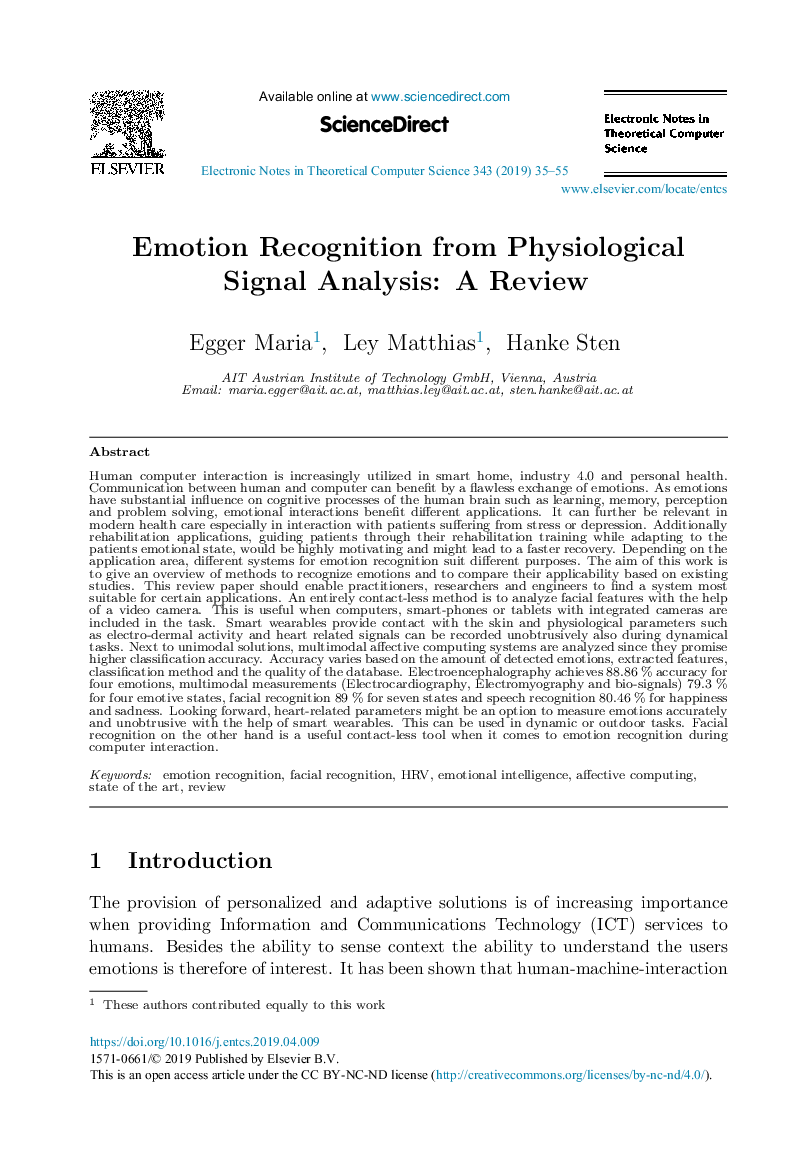| کد مقاله | کد نشریه | سال انتشار | مقاله انگلیسی | نسخه تمام متن |
|---|---|---|---|---|
| 13430455 | 1842468 | 2019 | 21 صفحه PDF | دانلود رایگان |
عنوان انگلیسی مقاله ISI
Emotion Recognition from Physiological Signal Analysis: A Review
دانلود مقاله + سفارش ترجمه
دانلود مقاله ISI انگلیسی
رایگان برای ایرانیان
کلمات کلیدی
موضوعات مرتبط
مهندسی و علوم پایه
مهندسی کامپیوتر
نظریه محاسباتی و ریاضیات
پیش نمایش صفحه اول مقاله

چکیده انگلیسی
Human computer interaction is increasingly utilized in smart home, industry 4.0 and personal health. Communication between human and computer can benefit by a flawless exchange of emotions. As emotions have substantial influence on cognitive processes of the human brain such as learning, memory, perception and problem solving, emotional interactions benefit different applications. It can further be relevant in modern health care especially in interaction with patients suffering from stress or depression. Additionally rehabilitation applications, guiding patients through their rehabilitation training while adapting to the patients emotional state, would be highly motivating and might lead to a faster recovery. Depending on the application area, different systems for emotion recognition suit different purposes. The aim of this work is to give an overview of methods to recognize emotions and to compare their applicability based on existing studies. This review paper should enable practitioners, researchers and engineers to find a system most suitable for certain applications. An entirely contact-less method is to analyze facial features with the help of a video camera. This is useful when computers, smart-phones or tablets with integrated cameras are included in the task. Smart wearables provide contact with the skin and physiological parameters such as electro-dermal activity and heart related signals can be recorded unobtrusively also during dynamical tasks. Next to unimodal solutions, multimodal affective computing systems are analyzed since they promise higher classification accuracy. Accuracy varies based on the amount of detected emotions, extracted features, classification method and the quality of the database. Electroencephalography achieves 88.86 % accuracy for four emotions, multimodal measurements (Electrocardiography, Electromyography and bio-signals) 79.3 % for four emotive states, facial recognition 89 % for seven states and speech recognition 80.46 % for happiness and sadness. Looking forward, heart-related parameters might be an option to measure emotions accurately and unobtrusive with the help of smart wearables. This can be used in dynamic or outdoor tasks. Facial recognition on the other hand is a useful contact-less tool when it comes to emotion recognition during computer interaction.
ناشر
Database: Elsevier - ScienceDirect (ساینس دایرکت)
Journal: Electronic Notes in Theoretical Computer Science - Volume 343, 4 May 2019, Pages 35-55
Journal: Electronic Notes in Theoretical Computer Science - Volume 343, 4 May 2019, Pages 35-55
نویسندگان
Maria Egger, Matthias Ley, Sten Hanke,